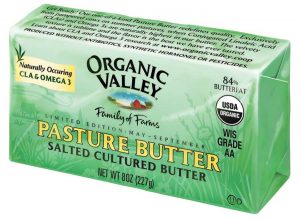Butter
Butter is America’s best and most easily absorbed source of Vitamin A., which is needed for a wide range of functions in the body, from maintaining good vision, to keeping the endocrine system in top shape. Vitamins A and D in butter are essential for the proper absorption of calcium and hence necessary for strong bones and teeth. Butter also contains the other fat-soluble vitamins E and K.
Butter contains lecithin, a substance that assists in the proper assimilation and metabolism of cholesterol and other fat constituents. Short and medium chain fatty acids in butter protect against pathogens and have strong anti-fungal effects (that means yeast and Candida.)
Butter is rich in trace minerals, especially selenium, a powerful antioxidant. Ounce for ounce, butter has more selenium per gram than either whole wheat or garlic. Butter also supplies iodine, needed by the thyroid gland (Vitamin A is also needed by the thyroid gland.)
Butter has appreciable amounts of butyric acid which are used by the colon as an energy source. Butyric acid is also a known anti-carcinogen. Lauric acid, also in butter is a medium chain fatty acid, which is a potent antimicrobial and antifungal substance. Butter also contains conjugated linoleic acid (CLA) which gives excellent protection against cancer.
When looking for good quality butter, raw and cultured is best and which may be hard to find. Organic butter is your next best choice, with store-bought butter being at the bottom. Butter made from grass-fed cattle is better for you because it has more of the healthier medium-chain fatty acids (and less E. coli.)
When Dr. Weston A. Price studied native diets in the 1930’s, he found that butter was a staple in the diets of many supremely healthy peoples.
Now, a little history on margarine: Margarine was originally manufactured to fatten turkeys. When it killed the turkeys, the people who had invested money into the research wanted a payback so they put their heads together. They added yellow coloring to the white substance and sold it to people to use in place of butter. All margarines are made from assorted vegetable oils that have been heated to extremely high temperatures. This possessing may be unsafe for your health.
Now, comparing margarine vs. butter:
- Both have the same amount of calories.
- Butter is slightly higher in saturated fats at 8 grams compared to 5 grams in margarine. Eating butter increases the absorption of many other nutrients in other foods.
- Butter has many nutritional benefits where margarine has a few—only because they are added.
- Most people think butter tastes much better than margarine and it can enhance the flavors of other foods. Butter has been around for centuries where margarine has been around for less than 100 years.
- Margarine is very high in trans-fatty acids which are carcinogenic and mutagenic. The US federal government requires the labeling of all food in such a way as to disclose amounts of trans-fat in products. Many brands label their products legally now as “zero grams” trans-fat, which in fact means less than 500 mg trans-fat per serving. I don’t know how they get away with this one.
- Some studies show that margarine triples the risk of coronary heart disease, increases total cholesterol and LDL (this is the bad cholesterol) and lowers HDL cholesterol, (the good cholesterol), increases the risk of cancers up to five fold and lowers the quality of breast milk. Eating margarine can increase heart disease in women by 53% when compared to eating the same amount of butter, according to a recent Harvard Medical Study. Other studies sponsored by the margarine promoters refute this.
- Other studies show that margarine decreases immune response and decreases insulin response.
- And here’s the most disturbing fact. . . Margarine is but ONE MOLECULE away from being PLASTIC. . .Yum.
Who eats margarine? Humans do. Now, here’s a test you can do at home:
Purchase a tub of margarine and leave it in your garage or shaded area. Within a couple of days you will note a couple of things:
- No flies, not even those pesky fruit flies will go near it (that should tell you something.)
- Margarine does not rot or smell differently because it has no nutritional value; nothing will grow on it. Hmm. . .come to think of it, the same thing happens with Kentucky Fried Chicken! Maybe they fry the chicken in trans-fats! That observation kind of bummed me out. I really liked their chicken before that.
Helpful Links and References for Butter vs. Margarine:
- The Oiling of America: https://www.westonaprice.org/oiling-of-america-in-new-york/
- https://en.wikipedia.org/wiki/Margarine (fairly unbiased view)
Note: I definitely have a biased view, but it’s my website and my gut instinct!
Thanks to my most favorite boss, Dr. Gary Thomas for sending me the impetus to write this part of the newsletter.
